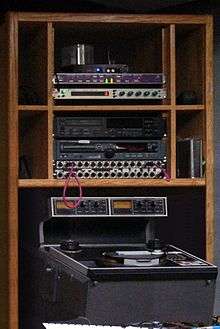Ampex ATR-100
.jpg)
The Ampex ATR-100 is a multitrack tape recorder, designed by Ampex Corporation, of Redwood City, California, United States. It was introduced at the Spring 1976 AES Conference in Los Angeles,[1] and was geared towards the ultra high end studio market. The original versions were designed specifically as a stereo or quadraphonic (2 or 4 track) mixdown and mastering deck. It has gained a reputation in the recording industry as the most accurate analogue tape recorder ever to be produced.
The ATR-100 was designed by a three-person design team consisting of Robert P. Harshberger Jr. (motors and control system), Alastair M. Heaslett (signal electronics) and Roger Sleger (mechanical systems).[2][3]
Features and design
Key features of the design are the machine's interchangeable headblock system, which allows the ATR-100 to be converted to run either quarter-inch or half-inch magnetic tape. Ampex was the first company to implement a servo-controlled, direct-drive-capstan tape transport, which allows the tape speed and tension to be continuously monitored by a servo relay. The transport consequently has excellent wow and flutter specifications. The ATR-100 also features dual VU meters, or four VU meters in the case of the four track models, and a digital tape timer. An optional remote control is also available.
Upgrade

(bottom, Mike Spitz-modified)
Approximately two years after the release of the ATR-100, Ampex released the next generation Ampex ATR-102, which was essentially the same machine as the ATR-100, with the exception of some repositioned components and slight design modifications.
Evolution
Following the success of the ATR-102, Ampex went on to release the 16-track Ampex ATR-116 and the 24-track Ampex ATR-124. Both machines were designed with the same transport and similar electronics. The Ampex ATR-124, though still widely regarded as the most accurate and best sounding multitrack ever produced, was a financial disaster for Ampex, resulting in only 62 being produced. Base price for these recorders in 1980 was $48,500 for the sixteen track machine and $62,500 for the 24 track machine. With additional components and customizations, either machine could easily reach over $100,000 in cost when it was originally released. Because of this, the Ampex ATR-124 is extremely rare, extremely expensive to service and maintain, and is referred to by many engineers as "The King of All Tape Machines."
References
- ↑ Alastair Heaslett
- ↑ Zide, Larry. "The Making of the Ampex ATR-100" db - The Sound Engineering Magazine, December, 1976. pages 32-35. http://www.americanradiohistory.com/Archive-DB-Magazine/70s/DB-1976-12.pdf
- ↑ Zide, Larry. "The Making of the Ampex ATR-100, Part 2" db - The Sound Engineering Magazine, February, 1977. pages 36-38 http://www.americanradiohistory.com/Archive-DB-Magazine/70s/DB-1977-02.pdf
External links
Chronology of Ampex Professional Products (Draft: 29 Oct 95; Rev. 4 Nov 99) Compiled by Howard Sanner. http://recordist.com/ampex/docs/histapx/ampchrn.txt